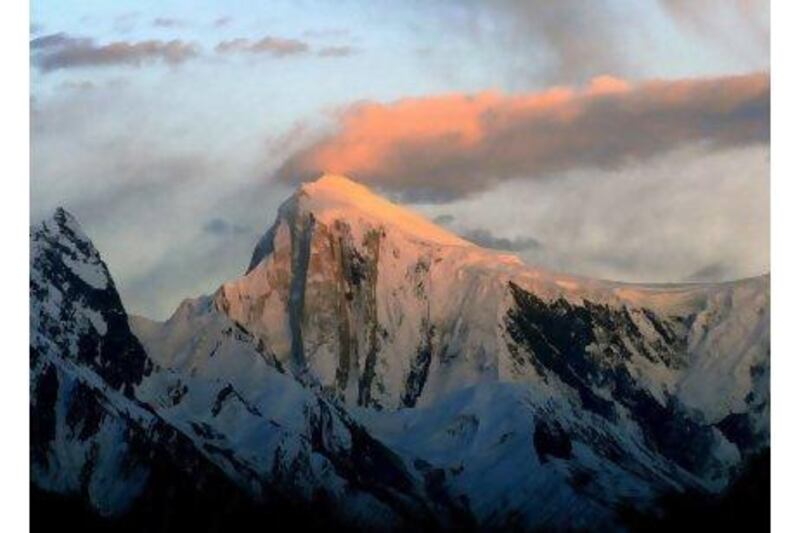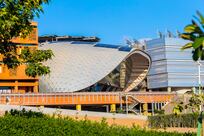Tourist interest in Pakistan falls into two camps, says Jonny Bealby, award-winning travel writer and moving force behind Wild Frontiers, a British adventure tour operator. "Those who will not countenance it, no matter what part of the country it is, and those that will travel across the north of the country." Via e-mail, Jonny and I are discussing Gilgit-Baltistan, the mountainous northern extreme of Pakistan that's so remote and culturally distinct from the rest of the country that terrorists can't get a foothold.
Wistfully, I ask Jonny what it's going to take to restore the popularity of a region that, before the September 11 terrorist attacks, was thronged by western tourists drawn by the myth of Shangri-la. Yes, the Shangri-la of James Hilton's Lost Horizon is in Hunza, Pakistan, not Tibet, although Tibet did rule the area for centuries.
"When I first started running tours here, I had to book hotels a year in advance. Now we can just show up," Jonny says. "For visitor levels to return to those of the mid-90s a huge amount would have to happen ... but the most important thing is Foreign Office advice." I check the British Foreign and Commonwealth Office website. Gilgit-Baltistan is safer than Islamabad, where I live, it says.
A week later and my photographer, Muzammil Pasha, and I are engrossed in a discussion about the spectacular view as our dinky but stable PIA turboprop flies north to Gilgit. The mountain peaks of the Himalaya and Karakorum that we are flying through are the result of the ancient collision between the Asia and India tectonic plates. When we clamber down the half-dozen steps at Gilgit airport, there is silence, the kind that prevails in any valley surrounded by towering mountains.
Farooq Ahmed, a Gilgit journalist and close friend, awaits us in the baggage room (too small be called a hall), grinning from jowl to jowl. After checking in at the Serena, a pleasant four-star hotel with badly conceived food, and a drive across what is admittedly a drab little town, we are soon cruising lazily through hilly countryside. The day's excursion is about sampling the region's culture, starting with the ancient and then moving forward to modern day.
Until the completion in 1978 of the 1,300-kilometre Karakorum Highway, the highest paved road in the world, linking Pakistan to China, Gilgit-Baltistan was isolated from the subcontinent by the Himalaya and Karakorum mountain ranges.
The first historical accounts of the region were written in the fifth to seventh centuries by pioneering Buddhist pilgrims from China. These amazing characters crossed it on foot, risking life and limb on mountain paths too terrifying to contemplate, in their endeavour to gather religious texts to take home. Kargah village, our first destination, was once a stopover for the exhausted pilgrims.
We enjoy the un-air-conditioned drive: it's June and horribly hot back down in Islamabad, but it feels more like mid-spring here, with the first crops of wheat, corn and mulberries being gathered by farming families as we drive by.
“Ah-ha-ha-hah!” says Muzammil.
He’s not laughing but expressing a Punjabi’s happiness at being enveloped by mountains, gushing streams and greenery. His trimmed white beard bristles with pleasure as we drive past a family gathering mulberries. A boy, who we can’t see, has climbed high up and is shaking off fruit for his mum, sisters and brothers to catch in an outstretched sheet.
Farooq’s resilient Toyota crawls up the side of a river gorge to the village of Kargah and stops to greet a lone police commando. The sub-machinegun-bearing cop is surprised to see visitors – a disappointing reaction considering he is standing 50 metres away from a three-metre-high Buddha carved into a cliff-face on the other side of the gorge, through which crash white-water rapids.
It was carved in the seventh century, according to my guide, Isobel Shaw’s Pakistan Handbook, and was part of a religious complex and stopover for pilgrims on their way– on foot – from China to Taxila, capital of a Buddhist empire that was being brought to a bloody end by invading White Huns.
The policeman says he’s posted here to discourage sectarian tensions between the locals, which occasionally draw blood but don’t involve visitors.
“What a waste,” moans Muzammil.
Sat in the shade of a tree, we mourn the neglect of Pakistan’s heritage between sips of buttermilk fetched by the policeman, until Farooq comes to the rescue, reminding us that heritage is still alive and, literally, kicking on the polo grounds of Gilgit-Baltistan.
“Great news for you! The regional polo final was postponed, so you haven’t missed it. This is going to be a good one!” he says, rubbing his hands.
He’s as enthusiastic as any sports fan, because polo is to Gilgit-Baltistan what football is to Brazilians.
Soon enough, we’re being ushered into a few remaining seats at Gilgit’s polo stadium, at the western end of the bazaar, and serenaded by a band of local musicians, playing pipes and drums, heralding team and players with signature tunes. Before the British colonialists arrived in the 19th century, this music was the region’s communications system, telling communities they were invited to a wedding, summoned by the local prince, or warning that an invasion was underway. Muzammil heads for a group of locals dancing by the musicians, each with variations in style that distinguishes them as residents of a particular valley, Farooq says.
This clearly isn't polo for toffs on manicured turf over hampers of strawberries, western-style – it's more like Ben Hur.
The largely grass-less pitch is narrow and long, prepared for play with a sprinkling of water by an aging fire truck, and is besieged on all sides by a packed, enthusiastic crowd that is at least 5,000-strong. Pretty much, that's about half the adult male population of Gilgit town, Farooq says. The only woman present is a cabinet minister.
The region’s chief minister, Mehdi Shah, tosses in the ball to start play, the shehnai (a kind of oboe) wail and the crowd roars as two teams of seven players all go for the prey at once.
Play alternates from one end to the other, without any fixed goal to defend, and the score is a matter of who shoots. Intensity is the natural by-product.
The potential for serious injury is obvious as the small mountain ponies gallop, twist and clash flanks, often in groups of three or four, with the rearguard swerving to avoid smashing into them. Riders are even dragged off their ponies when they fight to take the ball to hand – a move that sets up a free ride to the goalmouth. It also triggers a shoving match between rival stable hands, who launch suicidal equipment replacement missions on to the pitch every time a mallet breaks.
It is as up close and personal for most of the crowd, who are either sat on concrete steps next to the pitch or standing nervously behind the goal posts. Ever so often, the ball is ripped into the crowd, who fend it off and toss it back into play. The crazies behind the goalposts scatter like schools of fish to avoid the ball and the riders diving towards them.
We leave highly entertained, stopping at Rehmat’s Tikka stall in the bazaar for a grilled chicken offal-and-nan dinner that’s certainly superior to the four-star fare back at the hotel.
Next morning, we climb into a rented 4x4, essential for the drive into the Hunza Valley, desperate to be awed by the Karakorum and stunning terrain that has earned the area a consistent spot in the National Geographic magazine’s annual list of the Top 50 places to visit before you die.
The Karakorum Highway is into its third year of renovation and proves to be nothing more than a 24m-wide gravel track, made worse by neverending culverts over water channels.
The journey is initially arduous and grim as the valley narrows, and bleak, beige mountains threaten to spit a landslide.
Muzammil calls halt to photograph a team of labourers working on a landslide-proof tunnel. They're obviously not used to posing and stare blankly at him. Enough! Off sets Muzammil towards the youngest of the lot, and shocks us all by launching a tickle attack.
“Smile, for God’s sake!” he demands. Everybody roars with laughter as the young worker looks around for help.
The mood thus lightened, we resume the drive, following the list of things to see laid out by my guidebook, and soon enough we are in Chalt, staring across the valley at a cliff on which the rock layers run vertically rather horizontally. It’s a section of an island tipped on its side and sandwiched between Asia and India.
The valley broadens, half-ripened cherries abound, and the view becomes instantly that much easier on the eye as the magnificent Rakaposhi mountain comes into view.
A decent lunch is had at a viewpoint under sun brollies, sitting next to a glacial stream that acts as a readymade freezer for crates of soft drinks, held in place by rocks.
The path of the stream is easy to follow for thousands of metres up the world's longest unbroken mountain slope. The waiter at the two-dish outdoor restaurant tells us that Suzuki pick-up vans clamber up tracks every morning to loads blocks of ice to sell in Gilgit.
We press on, taking a total of four hours to reach the turning for Karimabad, the medieval capital of Hunza, and our home for the next couple of days. It has to await us a little longer as we divert onto a steep but otherwise good local road, cruising through lively village communities. It's late afternoon and the harsh high-altitude sunlight has abated, drawing men and women of all ages on to the streets for street-side natters, and youngsters to games of street cricket. The colourful caps of the elderly women draw my attention, and highlight the casual ease with which the genders are mixing publicly, albeit with modesty, unlike in the rest of rural Pakistan.
Driving between fields of potatoes, we reach the village of Duikar, home to the Eagle’s Nest hotel and lookout point, so named for the 3,000-metre-high ride it sits on. Its lawn and restaurant bestow a unique 240-degree panorama of 7,000-metre-plus mountain peaks, and watch the colourful interplay of the snow and fading sunlight.
A sound night’s sleep at the Darbar Hotel in Karimabad is followed by breakfast in a vast dining hall overlooking the Hunza Valley, the snow peaks framing a view layered height-wise, from glacier downward to forest, farmland, villages and the river.
The hotel belongs to Prince Ghazanfar Ali Khan, the head of the ruling family, and is full of the kind of family paraphernalia associated with former royals. It was under the Mirs of Hunza, who ruled under the suzerainty of China, that the rival British and Russian empires contested the area in the late 19th century. That rivalry, dubbed the Great Game by the British press, was sparked by a Russian attempt to buy access into the subcontinent from the Mir of Hunza. Instead, he was forced to flee by a British force, sent from Kashmir, firing bullets made from garnets before fleeing to China.
Such precious stones were on sale everywhere in Karimabad’s shopping precinct, where the ugly and commercial merrily co-exists with quaint village life.
It’s too early in the season even for domestic tourists, so we are practically the only visitors and exchange many a nod, smile and greeting with the evidently bored shopkeepers, and with grinning uniformed schoolchildren heading home after sitting their finals.
Karimabad’s historical significance emerges at the top of the bazaar, from where a cobblestone path leads us up to the daunting Baltit Fort, the former residence and court of the Mirs.
The tour is a morning well spent, as the knowledgeable, multilingual guide describes, room-by-room, a cramped but cosy royal lifestyle necessitated by the need to stay warm and safe from invaders.
There is further evidence of Hunza’s central role in regional power politics at Ganesh, the turning for Karimabad, where conserved rocks are adorned with graffiti left by travellers over the last couple of millennia. Their posts talk about shifts in political power along the Silk Route, either in Tibetan or the extinct languages of Brahmi, Gupta, Kharoshti and Sogdian, a signboard says.
By morning, we crave sanctuary from the tourist trail. I suggest Naltar Valley, and off we jog back down the highway, turning west across the Hunza River and upward along roads damaged by the previous year’s severe floods. It’s four-wheel drive much of the way, but it’s macho-fun following the thundering rapids up a gorge into the valley, which offers a temperate climate and scenery that’s more akin to the Alps than the Karakorum.
As the night closes in, the temperature suddenly drops and I’m soon wrapped in a quilt, sitting next to an open-air fire outside our no-frills but comfortable hotel, thrilled at feeling cold after a month of 40-degree days back in Islamabad.
We’re joined by a local contractor, an acquaintance of Farooq, who tells us the valley’s residents are members of the Gujjar tribe, the original cattle-herding natives, marginalised in the 16th century by the invading forefathers of the current majority, the Shina-speaking community.
Their abject poverty becomes obvious as we proceed up the valley next morning. Many still live in tiny, two-metre-high cottages made from riverbed rocks, and insulated by a roof covered with soil and the grass growing on it, which doubles as the living area.
I see my first yak as our 4x4 trundles through a charming forest, complete with mouldy brown floor, and over riverbed boulders on the way up to a lake renowned locally for its colours.
We arrive early and peer at the seven shades of algae that have colonised the bottom of the lake, leaving the surface water surprisingly crystal clear and usable by the local chaiwalla.
I drink some of his pond-water tea and live to tell the tale.
We are back in Gilgit for the last evening, spent at the town’s best barbecue and curry restaurant, Canopy Nexus. It has a platform, called “the boat”, which hangs over rush waters, but I don’t have sea legs and stick to the stability of the lawns.
My conversation with Farooq centres on the demise of tourism in Gilgit-Baltistan, renamed so in 2009 because the residents wanted to dissociate themselves from the militant havoc elsewhere in north-west Pakistan.
“We’re helpless to do anything about it,” says Farooq. I tell him what Jonny Bealby had told me.
Any revival in tourist interest depends on governments being able to assure travellers that Pakistan is safe – something that’s not going to happen anytime soon.
“That said our bookings are stronger than ever this year, so maybe people are starting to see that it’s a big country and not everywhere has a problem,” Jonny told me.
If you go
The flight Etihad Airways (www.etihadairways.com) flies from Abu Dhabi to Islamabad from Dh1,575 return. Pakistan International Airlines (www.piac.com.pk) flies from Islamabad to Gilgit for US$110 (Dh404) return; both including taxes.
The stay A double room at Serena Hotel (www.serenahotels.com) costs $142 (Dh522) per night. A double room at Darbar Hotel costs $72.45 (Dh266) per night. Call 00 92 321 9277881.
Correction: This article was changed on July 18, 2011 to correct the name of Jonny Bealby and the company Wild Frontiers.





